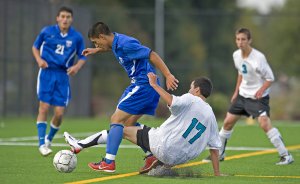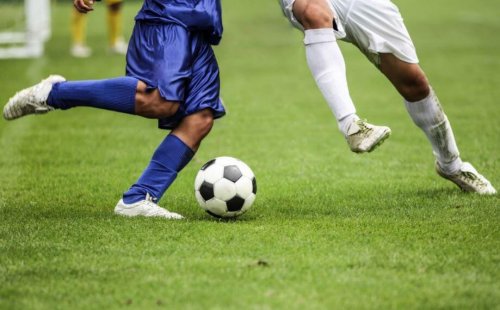What Muscles are Exercised in Soccer?

Soccer is one of the most demanding sports you can practice. In fact, this activity particularly puts the lower part of the body into motion, although you’ll also use the arms and abdomen to a large extent. In this article, you’ll learn which muscles are exercised in soccer. Keep reading to learn more!
We all know that soccer players are in very good physical condition. This is because the best soccer players need a combination of speed, agility, and endurance to beat their opponents in the field and kick the ball, among other things.
There’s no doubt that to play soccer, your cardiovascular condition must be excellent. As a matter of fact, soccer players are in constant motion, alternating between stable cardio and maximum speed.
Beyond that, strength and endurance are also necessary to succeed in this discipline; no matter the field position in which you play. In light of this, finding balance in your workouts is the best way to become a versatile player. Strength exercises are the basis of that process.
Doing strength exercises will help you keep your body strong and allow you to increase your speed, agility, and endurance; as well as adding some additional force to your kicks. A positive fact is that building muscles for soccer won’t require any sophisticated equipment.
What muscles are exercised in soccer?
Up next, you’ll find the list of muscles that are exercised in soccer. With this information, you’ll be able to know which muscles to focus on in your workouts. Take note!
1. Leg muscles
This sport demands a lot from our leg muscles. Thus, the muscles of the lower body activate to run, kick the ball, and perform jumps. More precisely, hamstrings and quadriceps are two of the most commonly used muscle groups.

Besides that, in soccer, we perform very few movements with both feet on the ground. In fact, lateral and vertical movements always require one foot as a base. This makes single-leg training vitally important.
Additionally, if you want to exercise your leg muscles, you can also carry out simple activities, such as long-distance running, sprint exercises, or squats.
2. Glutes and hip muscles
Having explosive strength to beat other players in soccer requires more than just the action of the leg muscles. Your glutes and hip muscles are also essential.
Consider that when you kick a ball, there’s a relationship between the speed of your foot and the speed of the ball. The speed of your foot combines several factors that include the rotation of the hip or the strength of your glutes, among others.
3. Arms, neck, and shoulders: other muscles that are exercised in soccer
It’s not enough to train the lower body and do cardio exercises. You must also train the upper body to be a good soccer player.
The ability to collide with the defenders and move them away from the ball is also very important. In this scenario, having strength in the arms and shoulders will also allow you to make better throws.
Likewise, maintaining balance and posture to protect the ball or pick it up requires a strong upper body. The musculature of the arm is an important part of the overall strength of a soccer player.
Ultimately, well-developed biceps, triceps, and shoulders will also help increase a player’s physical capabilities, which is useful for protecting the ball. These muscles act to balance a player while jumping or running with the ball.

4. Abs
Although it’s difficult to believe, abs are one of the muscles that we use the most in this sport. In truth, all movements in soccer require the commitment of your abdominal, oblique, and even lower back muscles.
Whether you’re fighting a player to get the ball, performing an explosive movement to beat or struggle against a player in the goal area, or kicking the ball with all of your strength, the abs play a key role in this sport.
In short, the nature of soccer demands a high commitment from specific muscle groups. If you don’t warm-up, exercise, and stretch them properly, the consequences can be serious. Focus on conditioning each of them to become a better soccer player!
Soccer is one of the most demanding sports you can practice. In fact, this activity particularly puts the lower part of the body into motion, although you’ll also use the arms and abdomen to a large extent. In this article, you’ll learn which muscles are exercised in soccer. Keep reading to learn more!
We all know that soccer players are in very good physical condition. This is because the best soccer players need a combination of speed, agility, and endurance to beat their opponents in the field and kick the ball, among other things.
There’s no doubt that to play soccer, your cardiovascular condition must be excellent. As a matter of fact, soccer players are in constant motion, alternating between stable cardio and maximum speed.
Beyond that, strength and endurance are also necessary to succeed in this discipline; no matter the field position in which you play. In light of this, finding balance in your workouts is the best way to become a versatile player. Strength exercises are the basis of that process.
Doing strength exercises will help you keep your body strong and allow you to increase your speed, agility, and endurance; as well as adding some additional force to your kicks. A positive fact is that building muscles for soccer won’t require any sophisticated equipment.
What muscles are exercised in soccer?
Up next, you’ll find the list of muscles that are exercised in soccer. With this information, you’ll be able to know which muscles to focus on in your workouts. Take note!
1. Leg muscles
This sport demands a lot from our leg muscles. Thus, the muscles of the lower body activate to run, kick the ball, and perform jumps. More precisely, hamstrings and quadriceps are two of the most commonly used muscle groups.

Besides that, in soccer, we perform very few movements with both feet on the ground. In fact, lateral and vertical movements always require one foot as a base. This makes single-leg training vitally important.
Additionally, if you want to exercise your leg muscles, you can also carry out simple activities, such as long-distance running, sprint exercises, or squats.
2. Glutes and hip muscles
Having explosive strength to beat other players in soccer requires more than just the action of the leg muscles. Your glutes and hip muscles are also essential.
Consider that when you kick a ball, there’s a relationship between the speed of your foot and the speed of the ball. The speed of your foot combines several factors that include the rotation of the hip or the strength of your glutes, among others.
3. Arms, neck, and shoulders: other muscles that are exercised in soccer
It’s not enough to train the lower body and do cardio exercises. You must also train the upper body to be a good soccer player.
The ability to collide with the defenders and move them away from the ball is also very important. In this scenario, having strength in the arms and shoulders will also allow you to make better throws.
Likewise, maintaining balance and posture to protect the ball or pick it up requires a strong upper body. The musculature of the arm is an important part of the overall strength of a soccer player.
Ultimately, well-developed biceps, triceps, and shoulders will also help increase a player’s physical capabilities, which is useful for protecting the ball. These muscles act to balance a player while jumping or running with the ball.

4. Abs
Although it’s difficult to believe, abs are one of the muscles that we use the most in this sport. In truth, all movements in soccer require the commitment of your abdominal, oblique, and even lower back muscles.
Whether you’re fighting a player to get the ball, performing an explosive movement to beat or struggle against a player in the goal area, or kicking the ball with all of your strength, the abs play a key role in this sport.
In short, the nature of soccer demands a high commitment from specific muscle groups. If you don’t warm-up, exercise, and stretch them properly, the consequences can be serious. Focus on conditioning each of them to become a better soccer player!
All cited sources were thoroughly reviewed by our team to ensure their quality, reliability, currency, and validity. The bibliography of this article was considered reliable and of academic or scientific accuracy.
- Ekstrand, J., Hägglund, M., & Waldén, M. (2011). Epidemiology of muscle injuries in professional football (soccer). American Journal of Sports Medicine, 39(6), 1226–1232. https://doi.org/10.1177/0363546510395879
- Hides, J. A., Brown, C. T., Penfold, L., & Stanton, W. R. (2011). Screening the Lumbopelvic Muscles for a Relationship to Injury of the Quadriceps, Hamstrings, and Adductor Muscles Among Elite Australian Football League Players. Journal of Orthopaedic & Sports Physical Therapy, 41(10), 767–775. https://doi.org/10.2519/jospt.2011.3755
- Donnelly, C. J., Elliott, B. C., Doyle, T. L. A., Finch, C. F., Dempsey, A. R., & Lloyd, D. G. (2015). Changes in muscle activation following balance and technique training and a season of Australian football. Journal of Science and Medicine in Sport, 18(3), 348–352. https://doi.org/10.1016/j.jsams.2014.04.012
- Escamilla, R. F., & Andrews, J. R. (2009). Shoulder muscle recruitment patterns and related biomechanics during upper extremity sports. Sports Medicine. https://doi.org/10.2165/00007256-200939070-00004
This text is provided for informational purposes only and does not replace consultation with a professional. If in doubt, consult your specialist.








